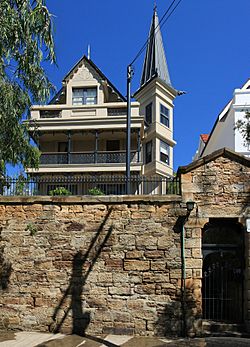Highroyd, Annandale facts for kids
Quick facts for kids Highroyd |
|
|---|---|

Highroyd after restoration
|
|
| Former names | Melba |
| General information | |
| Type | House |
| Architectural style | Victorian Rustic Gothic Revival |
| Location | 262 Johnston Street, Annandale, New South Wales |
| Country | Australia |
| Coordinates | 33°52′31″S 151°10′24″E / 33.8753°S 151.1732°E |
| Construction started | 1886 |
| Completed | 1889 |
| Client | John Young |
| Design and construction | |
| Architect |
|
|
Invalid designation
|
|
| Official name | "Highroyd", house |
| Type | Built |
| Criteria | a., b., c., d., e., f., g. |
| Designated | 23 December 2013 |
| Reference no. | Local register |
| Group/collection | Residential buildings (private) |
| Category | House |
| Builder | John Young |
Highroyd is a special house located in Annandale, a suburb of Sydney, Australia. It's so important that it's listed on a special heritage list by the local council. This means it's protected because of its history and unique design.
Contents
The Story of Highroyd
Highroyd was built by a famous builder named John Young. He moved to Australia from England in 1855. After working in Victoria for a while, he settled in Sydney in 1866.
John Young built many important buildings in Sydney. These include St Mary's Cathedral. In 1877, he bought a large piece of land near Rozelle Bay. This area is now known as Annandale.
A Dream Suburb
John Young had a big dream. He wanted to create a fancy suburb that would be as good as other exclusive areas in Sydney. He planned for Johnston Street, the main road in this new area, to be "the finest street in the colony."
On the west side of Johnston Street, he built eight large, very unique houses. The most important of these was The Abbey. This was a grand sandstone mansion that looked a bit like a Scottish castle. People have said it's a building you won't forget once you see it. John Young built The Abbey for himself and his wife, but they never actually lived there. They lived in another house called Kentville, which has since been taken down.
The "Witches Houses"
After The Abbey, John Young built other houses in a line. These were Oybin, Rozelle, Greba, Hockindon, Highroyd, Kenilworth, and Claremont.
Highroyd and Hockindon were built for John Young's daughters. They look almost exactly alike! The only difference is that Highroyd has a tall, pointed roof called a spire, and Hockindon does not.
Highroyd, Hockindon, and Kenilworth are often called the "witches houses." This is because their spires look a lot like witches' hats! These houses were also special for another reason: they used reinforced concrete, which was a very new building method back then.
Changes Over Time
In the 1890s, there was a difficult economic time. This meant that John Young's dream of a fancy suburb began to fade. The area changed, and his unique houses started to decline.
The "witches houses" were divided into smaller apartments. Sadly, Rozelle and Claremont were even torn down. New apartment buildings were built in their place.
Bringing Highroyd Back to Life
In 1988, Highroyd was sold. A skilled architect named David Springett began the huge job of restoring the house. This meant fixing a lot of damage that had happened over many years.
The Restoration Process
Some people who lived there before had painted bright murals on the walls. They even covered the beautiful cedar staircase with a thick layer of green paint! Scraping all that paint off the stairs was a massive job. It took six months just to clean the staircase.
The front of the house used to have lovely wrought iron balconies. But previous owners had closed them in to make more room. To fix this, new wrought iron had to be specially made to match the original design.
The spire also needed special decorations. Gargoyles are carved stone figures, often shaped like monsters. A sculptor named Hugh Reedman was hired to create four new gargoyles for the spire. These heavy stone figures had to be carefully lifted into place using a crane!
The restoration of Highroyd took a very long time – twenty years in total! All that hard work paid off. In 2009, the house was recognized for its amazing restoration. It was entered into the heritage category of the Australian Institute of Architects New South Wales awards.
Gallery




